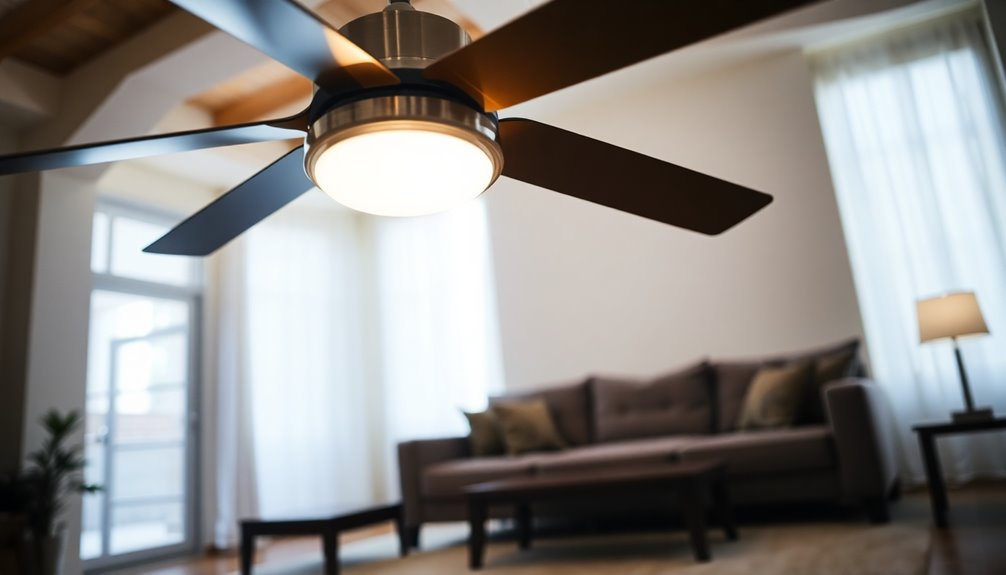The chances of a ceiling fan falling on you are extremely low—about 1 in 1 million. However, improper installation and neglect can increase this risk. Regular maintenance checks can spot potential issues before they escalate, helping to guarantee your fan remains securely attached. Environmental factors like high winds or seismic activity can also play a role. Want to learn more about how to keep your ceiling fan safe and secure?
Key Takeaways
- The likelihood of a ceiling fan falling is extremely low, estimated at 1 in 1 million.
- Proper installation by qualified professionals significantly reduces the risk of ceiling fan failure.
- Regular maintenance can identify and address wear and tear, ensuring fans remain securely attached.
- Environmental factors like high winds and seismic activity can increase the risk of falling fans.
- Awareness of these risks and proactive inspections are essential for ensuring safety around ceiling fans.

Although the chances of a ceiling fan falling are quite low, it's essential to understand the factors that can increase that risk. With estimates suggesting that only about 1 in 1 million ceiling fans may experience failure due to improper installation or maintenance, it's clear that you're more likely to be struck by lightning than to have a ceiling fan fall on you.
However, a few key elements can heighten the chances of a mishap.
Age is one important factor. Many ceiling fans are designed to last for over a decade, but if you neglect regular maintenance, you could be inviting trouble. Components may loosen or fail, increasing the risk that the fan could detach from the ceiling. Regularly checking your fan for signs of wear and tear can help catch issues before they become severe.
Quality of installation also plays a vital role. Building codes typically require that ceiling fans be properly installed and secured. If your fan was installed by a novice or if it doesn't meet local building codes, the risk of it falling increases. Make sure to hire a qualified professional for installation to guarantee everything's up to standard.
Another factor is the environment. High winds or seismic activity can put additional stress on the fan. If you live in an area prone to such conditions, you should verify your fan is adequately anchored. Otherwise, those natural forces could lead to unexpected consequences.
While the statistical likelihood of a ceiling fan falling seems reassuring, it's important to remain cautious. Regular maintenance, proper installation, and awareness of environmental risks can dramatically reduce the chance of a mishap.
Don't wait for a problem to arise; proactively inspect your ceiling fan and confirm it's in top condition.
Frequently Asked Questions
How Likely Is It for My Ceiling Fan to Fall?
You might be wondering how likely it's for your ceiling fan to fall. The chances are quite low, with estimates suggesting about 1 in 10,000 fans could fail under normal conditions.
However, factors like improper installation or lack of maintenance can increase that risk.
To keep your fan safe, make sure it's installed correctly and check it regularly for any loose parts or dirt that could affect its stability.
How Common Are Ceiling Fan Accidents?
Ceiling fan accidents are more common than you might think, with about 3,000 injuries reported annually in the U.S.
Most of these incidents result from improper installation or neglecting maintenance.
You mightn't realize that children are particularly at risk, facing head trauma and lacerations in poorly kept environments.
What Happens if a Ceiling Fan Hits You?
If a ceiling fan hits you, you could face serious injuries like concussions, lacerations, or fractures, depending on the fan's weight and height.
You might need immediate medical care, and there could be long-term effects, such as chronic pain.
On top of that, the incident could leave you feeling anxious or fearful.
It's essential to document your injuries and seek medical attention quickly to establish a link for any potential claims.
Can a Wobbly Ceiling Fan Possibly Fall?
Ever had that moment of dread when a wobbly ceiling fan catches your eye?
Yes, a wobbly ceiling fan can definitely fall. It often indicates an imbalance, usually due to loose blades or improper installation. If it looks like it's struggling to stay up, it's time to act.
Regular inspections and tightening screws can keep it secure and reduce your risk.
Don't ignore those warning signs—your safety's worth it!
Conclusion
So, imagine this: you're relaxing under a gently spinning ceiling fan, its blades slicing through the warm air, creating a soothing breeze. The odds of that fan plummeting down are slim, almost like a feather drifting down from the sky. With proper installation and maintenance, you can enjoy your fan without worry. So, sit back, breathe easy, and let the soft hum lull you into comfort—your ceiling fan is more friend than foe, keeping you cool and safe.









